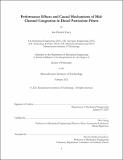Performance effects and causal mechanisms of mid-channel congestion in diesel particulate filters
Author(s)
Tracy, Ian Patrick.
Download1252630559-MIT.pdf (9.571Mb)
Other Contributors
Massachusetts Institute of Technology. Department of Mechanical Engineering.
Advisor
Wai Cheng.
Terms of use
Metadata
Show full item recordAbstract
The diesel particulate filter (DPF) is a ~$5,000-$50,000 USD critical component of aftertreatment systems installed in diesel engine-powered vehicles. The device is designed to trap particles emitted by the diesel combustion process in order to prevent their release into the surrounding environment, thereby reducing pollution levels and mitigating greenhouse gas emissions. Increasing stringency of emissions regulations has progressively necessitated the installation of DPFs on diesel-powered vehicles over the past few years, with the DPF market expected to remain significant in size at least through 2025. While DPFs nominally operate by trapping and accumulating incoming PM continuously in the far downstream plug region of the filter channels so that no gaps form between trapped particulate matter (PM) agglomerates, both real-world field and laboratory bench tests have demonstrated that channel-spanning ash agglomerates form well upstream of the end plug region, prematurely clogging the mid-channel region. This effectively renders useless the remaining open space in the channel downstream of the blockage location. In addition to mid-channel congestion, this adverse phenomenon is referred to in the literature interchangeably as mid-channel collapse (MCC), mid-channel clogging, and mid-channel deposits (MCD). MCC, due to accelerated filling of the filter channels, often results in significantly reduced DPF lifetime and performance (i.e. increased backpressure yielding depressed fuel economy), both of which prove costly for diesel vehicle operators. Existing hypotheses regarding causality of MCC are largely based on inconclusive empirical observations, and not substantiated by fundamental quantitative analysis. The primary contributions of this dissertation include: 1) summarizing hypothesized causal mechanisms of MCC with an emphasis on sintering as a primary driver thereof, 2) introducing a method by which to analyze X-Ray CT scans that show MCC in DPF channels, 3) assessing the performance penalty associated with MCC by correspondingly extending the industry standard model for pressure drop across a DPF, and 4) suggesting modifications to the DPF regeneration process in order to prevent sintering of ash agglomerates to the DPF side walls, based on an efficient reformulation of the prevalent temperature history model of the DPF that solves for both flow and temperature conditions inside filter channels over time during active regeneration.
Description
Thesis: Ph. D., Massachusetts Institute of Technology, Department of Mechanical Engineering, February, 2021 Cataloged from the official PDF of thesis. Includes bibliographical references (pages 215-226).
Date issued
2021Department
Massachusetts Institute of Technology. Department of Mechanical EngineeringPublisher
Massachusetts Institute of Technology
Keywords
Mechanical Engineering.